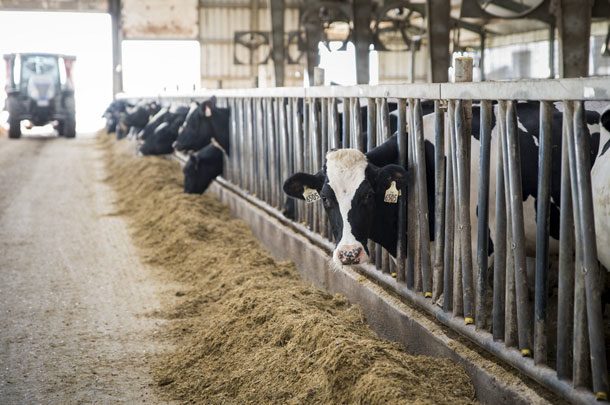“My feed bill is too high. How can I cut my feed costs?” As nutritionists, it’s a question we hear often. And, on dairies with robots, it’s no different.
But, that question often has more to it than meets the ear. It’s a signal that there may be a cash-flow issue – there’s not enough dollars remaining after paying the feed bill to pay other bills. Feed is typically the highest cost, so it can seem like a logical place to start cutting, but often times, that isn’t the case.
To optimize cash flow, it’s important to manage your income over feed cost (IOFC). IOFC tells you the dollars left after taking value of milk produced and subtracting your total feed costs; dollars that can be used to pay other expenses like labor and animal health and can result in profit.
Measuring IOFC on a robotic dairy is the same as a conventional dairy. The only difference is the tool – or milking system – used to achieve the IOFC. Consider these factors to make sure your IOFC is trending upward:
Factor in homegrown feed costs
Whether you have a robotic or conventional milking system, it’s easy to pay close attention to purchased feed costs – you get a bill you can quickly total up and punch into the IOFC calculation. Homegrown feeds aren’t as simple, since you likely have multiple bills that span months. You also must take inventory of forage, calculating acreage, tons per acre, inventory and shrink.
Without monitoring homegrown feed costs, your IOFC can paint an inaccurate picture, causing you to make decisions that actually hurt efficiency. The bottom line is, just because you aren’t measuring it doesn’t mean it’s not costing you. Including both homegrown feed and purchased feed costs can help you make smarter decisions on where to gain efficiency in your operation.
If you’re not sure where to start calculating homegrown feed costs, work with your nutritionist and agronomist as a team. Together, they can help you analyze total costs of homegrown feed and give you an accurate representation to use in your IOFC calculation.

Work with your nutritionists and agronomists to calculate and manage your IOFC. Photo courtesy of Purina Animal Nutrition.
Balance what’s fed in the robot and the feed bunk
An efficient diet will meet cow nutrient needs for optimal milk production, make best use of available forages and balance the remainder with purchased feed. Not only that, but in a robot system, a well-balanced diet will keep cows efficiently moving to the robot and help optimize IOFC.
Forages will ultimately determine the balance between robot and bunk diets, especially in free-flow traffic. If you have a high-quality corn silage diet, your cows are probably getting a fair amount of energy within the bunk diet, and you may not need to feed as much through the robot. Or, vice versa; if you have a bunk diet high in haylage with lower energy, you may need to feed more through the robot to make up the energy difference. However, in a milk-first preselection guided layout, the feeding system may resemble a total mixed ration (TMR) where minimal robotic feed is required. Another consideration is the feed form through the robot – pellet versus meal – and how that impacts cow behavior and milk production.
No matter how your diet balance shakes out, you’ll need a minimum percentage of the diet fed in the robot to entice cows to enter for milking. Keep an eye on robot traffic and key indicators like refusals and gate passes. An uptick in these indicators might mean you need to adjust where diet nutrients are offered and modify feed offered through the robot to influence cow traffic and milk production.
Work with the robot to deliver precise nutrition
In a robotic milking system, lactation curves remain the same as in a traditional system. The key difference between the two systems is the robot allows you to more precisely deliver nutrients to match individual cow needs, given her stage of lactation and milking frequency. This precision allows you to utilize feed more efficiently to maximize IOFC.
Getting the right cows to the robot at the right time is one aspect. For example, fresh cows need more milkings early in lactation to drive up milk production. Fresh cows also need to get to the robot consistently to ride the peak milk curve as long as possible. These cows also require the most nutrition, and nutrition can be an important driver of cow behavior and traffic to the robot.
Ideally, there should be enough robot capacity for fresh and peak cows to get to the robot an average of three and a half times per day versus a feed-hungry cow that’s 250 days in milk, well past her peak, just seeking out extra food. Later lactation cows only need to average two visits to the robot per day.
The robot needs to be set up correctly to kick out the over-visiting late-lactation cow to free up capacity for the transition or peak-lactation cows who need extra visits.
Connect cow behavior and nutrition
Nutrition is a key aspect of IOFC. But, you can’t forget about the other side of the coin – cow management. One of the most common mistakes in robotic milk systems is focusing on the robot and forgetting about the cows. Uniting animal behavior and nutrition delivery will help you make the most of your robotic milk system and increase feed efficiency, leading to improved IOFC.
Cow behavior is greatly impacted by feed delivery – either in the bunk or in the robot, based on robotic settings. Evaluate animal activity patterns, bunk space and lying times to get a sense of cow behavior and adapt nutritional strategies to encourage the desired cow behavior, leading to a more optimized IOFC.
IOFC is a great tool for producers to improve their operational efficiency and improve cash flow. Each dairy is different and has different strategies to meet their IOFC goals. Work with your nutritionist to fine-tune your rations and optimize IOFC.







